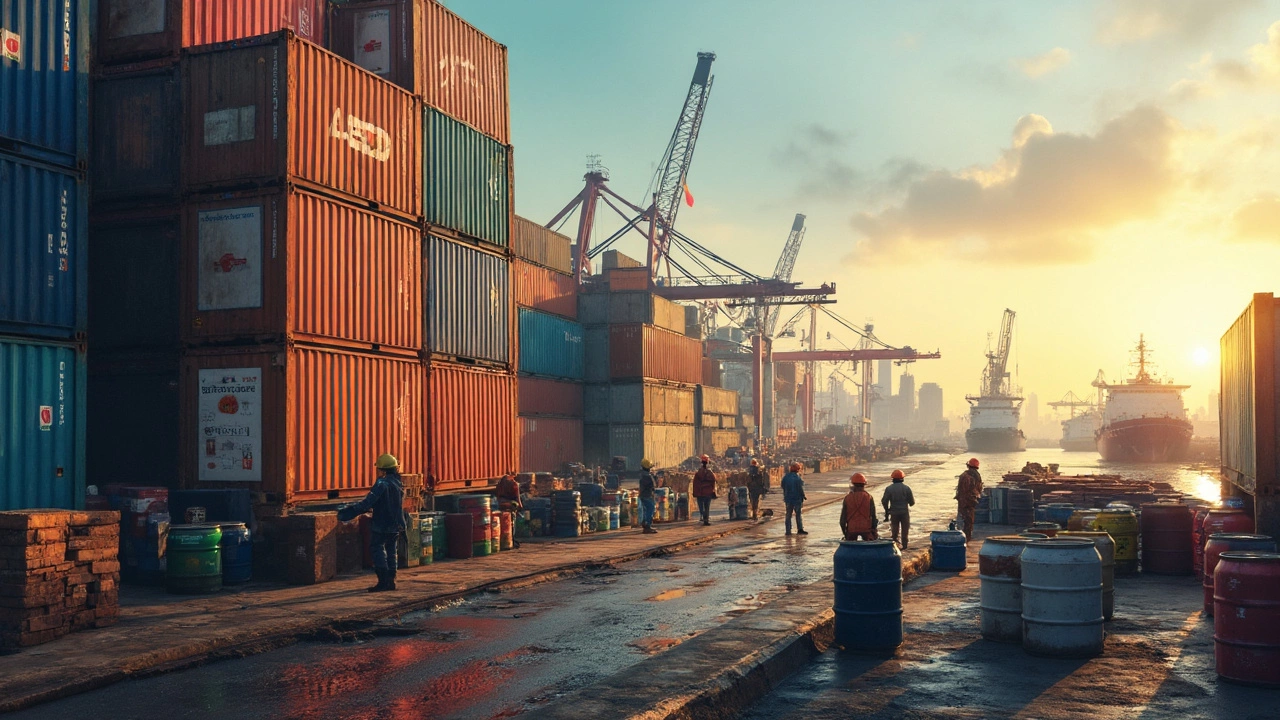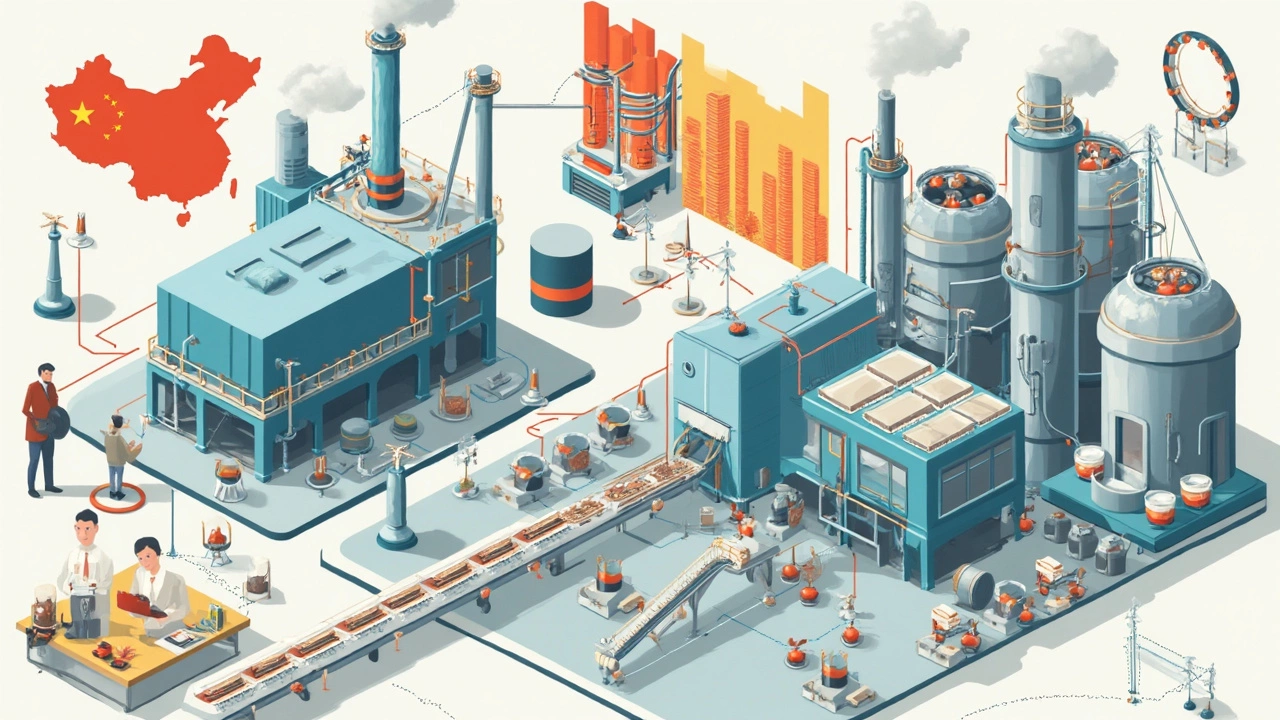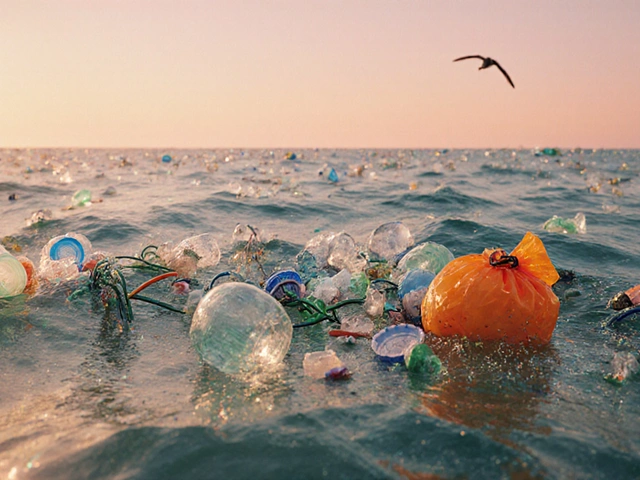
If you run a chemical-based business in India, you know how much the country leans on imports to keep factories and labs running. Demand outpaces local supply almost every year. So where do these chemicals actually come from, and which one tops the charts?
First, here’s the straight answer: India mostly imports organic chemicals. These are essential for everything from making everyday medicines and fertilizers to dyes and paints. Need numbers? Organic chemicals make up over a fifth of the country’s total chemical imports—last year’s data showed that India spent more than $20 billion just on this category.
Why does this matter so much? Well, most Indian manufacturers can’t make these specialty products at scale, or with the purity required for use in things like pharmaceuticals. Without steady imports, whole industries would grind to a halt.
If you’re involved in sourcing or manufacturing, knowing which chemicals flow in most can help you make smarter buying decisions, negotiate better deals, or spot market shifts before your competitors.
- Why Does India Import So Many Chemicals?
- The Most Imported Chemical: Which One Tops the List?
- China’s Role and Trade Partners
- Recent Trends: What’s Changing in 2025?
- Smart Tips for Chemical Importers in India
Why Does India Import So Many Chemicals?
India depends on chemical imports for a simple reason: the country’s chemical industry can’t keep up with the insane local demand. India is one of the top global users of chemicals, driven by its booming pharma, agriculture, textiles, and manufacturing sectors. The machines need to run nonstop, but local plants just can’t crank out enough of the right types or quality.
One huge problem is technology. Some specialized chemicals need advanced processes that only a few countries—like China, Germany, or the US—do well. Setting up this tech in India means massive investment and years of know-how, and most manufacturers just can’t match that speed or precision. So, businesses rely on imports to fill that gap—especially for high-end organic chemicals, which make up a major chunk of the chemical imports India market.
Raw material shortages are another headache. Not all chemicals can be made in India because the natural resources or base chemicals just aren’t available locally. Instead of wasting time and money on substitutes, it’s easier—and often cheaper—to import what you need.
Here’s an eye-opener: Over 40% of India’s chemical imports come just from China. China has the big factories and supply chains locked down, so Indian businesses often turn there first. Other major import partners include the US, South Korea, and Saudi Arabia.
| Country | India’s Chemical Imports Share (2024) |
|---|---|
| China | 41% |
| United States | 11% |
| South Korea | 9% |
| Saudi Arabia | 6% |
| Germany | 5% |
Why won’t this change overnight? Upgrading local manufacturing is slow and expensive. Plus, import duties for many chemicals are actually pretty low, which makes bringing in stuff from abroad even more attractive. Until homegrown tech and infrastructure catch up, importing will stay the best option for most companies.
The Most Imported Chemical: Which One Tops the List?
When it comes to India’s chemical trade, one name keeps popping up: organic chemicals. But that’s a broad category, so let’s break it down to what dominates the import bill. If you had to bet on a single product, bet on active pharmaceutical ingredients (APIs) and bulk chemicals like methanol, acetic acid, and phenol. These are at the core of India’s huge pharma and plastics scenes.
APIs are the chemical building blocks for medicines. Even with India called the “pharmacy of the world,” it imports nearly 70% of its APIs – most of them coming from China. Methanol is another heavyweight, used for everything from plastics and adhesives to paints. In 2024, methanol alone accounted for over $1.2 billion of India’s chemical imports.
Here’s a quick snapshot of the top imported chemicals, so you can see where the money goes:
| Chemical Name | 2024 Import Value (USD Billion) | Main Use |
|---|---|---|
| Bulk Organic Chemicals (APIs) | 7.5 | Pharmaceuticals |
| Methanol | 1.2 | Plastics, adhesives, solvents |
| Acetic Acid | 0.9 | Food additives, plastics, textiles |
| Phenol | 0.7 | Resins, medicines, disinfectants |
| Caustic Soda | 0.6 | Textiles, paper, soap |
If you’re dealing with any of these products, expect a competitive import market—and plenty of attention from traders tracking prices and supply chain issues. Smart businesses follow the volumes, keep an eye on price changes, and try to lock in long-term deals when global prices are low. You really don’t want to wait for a shortage; that’s when prices shoot up overnight.

China’s Role and Trade Partners
When it comes to chemical imports into India, China stands out by a huge margin. Over 35% of India’s total chemical imports come straight from Chinese factories. If you’re talking about chemical imports India, you’re almost always talking about China’s dominance. The key reason? Chinese companies produce chemicals at massive scale and much lower costs than Indian factories can manage. That’s especially true for organic chemicals—like APIs (active pharmaceutical ingredients), bulk drugs, and specialty chemicals.
It's not just about price. Many Chinese suppliers have been in the game for decades and know exactly how to cater to India’s pharma and manufacturing needs, whether you’re buying tons of solvents or smaller volumes of specialty intermediates. China also supplies a huge chunk of dyes, agrochemicals, and fertilizers, which are crucial for India’s agri-business and textile industries.
Let’s look at the real numbers for last year:
| Top Source Countries | Share of India’s Chemical Imports (%) | Main Imported Product Types |
|---|---|---|
| China | 35.2 | Organic chemicals, dyes, APIs |
| USA | 8.7 | Specialty chemicals, plastics |
| Saudi Arabia | 7.5 | Petrochemicals, fertilizers |
| Germany | 6.3 | Specialty and organic chemicals |
| Singapore | 4.1 | Bulk chemicals, intermediates |
India isn’t putting all its eggs in one basket, though. Imports from the USA, Saudi Arabia, Germany, and Singapore are rising, especially when it comes to high-grade specialty chemicals and petrochemicals. This spread helps protect Indian manufacturers from surprises, like sudden price jumps or supply chain hiccups from a single country.
If you’re looking to import, it pays to understand these trade flows. China offers unbeatable prices for large-volume basics, but the USA and Europe can be better for niche or super high-quality stuff. Think about your business’s mix. Flexibility is smart, since trade policies can shift fast.
Recent Trends: What’s Changing in 2025?
This year, there’s been a shakeup in the way India is managing its chemical imports. Here’s what has everyone talking in the industry.
The cost of organic chemical imports is at an all-time high, with import values hitting around $21 billion in the last financial year. Major factors driving this spike include rising global raw material prices, currency swings, and shifts in government policies after 2024’s election.
Government is now pushing for local manufacturing through the "Make in India" scheme, but it's not quick to fill the gap—especially for things like specialty chemicals and pharma ingredients. The pharma sector, which accounts for nearly 35% of organic chemical imports, continues to rely on China and a few other countries for advanced intermediates. Getting these from alternative suppliers has only driven costs higher.
| Top Chemical Import (2024-25) | Import Value (USD Billion) | Top Source Country |
|---|---|---|
| Organic Chemicals | 21 | China |
| Fertilizer Chemicals | 8.5 | Russia |
| Specialty Chemicals | 4 | USA |
A big trend in 2025: more chemical manufacturers in India are teaming up with global partners to lower dependence on one country—mainly China. But that’s just starting, so your options as a buyer still feel limited.
Another shift is digital procurement. Now, more companies use online platforms to track shipments and compare prices internationally. This has made deal-making faster, but it also means you’ve got to keep up with market prices that change almost weekly.
Want an edge this year? Focus on keeping a close eye on the chemical imports India prices, watch new government tariffs, and don’t put all your eggs in one basket. Finding backup suppliers—even if they’re a bit pricier—can help you avoid nasty surprises if there’s another sudden trade dispute or raw material shortage.

Smart Tips for Chemical Importers in India
If you’re importing chemicals into India, the landscape can change overnight—a new regulation, a shipping delay, or a spike in global prices can hit your bottom line fast. Here are some practical tips made for today’s market.
- Chemical imports India are highly regulated. You can’t just buy and ship what you want. Make sure you stay updated on the latest import policies from the Directorate General of Foreign Trade (DGFT). Regulations for chemicals like benzene and methanol can change with little warning.
- Focus on reliable suppliers. China still leads as India’s top source, but don’t put all your eggs in one basket. Explore new suppliers from Southeast Asia or Europe, especially for products impacted by geopolitical issues.
- Keep an eye on real-time freight rates. Chemical shipping is pricey and timing matters. Booking your shipments in advance can save huge costs, while tracking global freight trends (check sites like Freightos) can help you avoid getting ripped off.
- Customs paperwork isn’t just busywork—it’s vital. Use a licensed customs broker who understands chemical codes and duty drawbacks, and always check your paperwork for errors. Even small mistakes can lead to big delays at the port.
- Stay compliant with BIS standards. The Bureau of Indian Standards is making more chemicals subject to Indian certification. If your product falls under this category, start the paperwork early. Getting held up because of missing certifications can mess up your entire supply chain.
- Watch your exchange rates. Chemical purchases are usually in USD, but INR value swings can affect your costs. Consider hedging tools if you’re signing big contracts that stretch over months.
- Join local industry groups like the Indian Chemical Council or CHEMEXCIL. These aren’t just for news—they help with government advocacy, updates on global disruptions, and even provide leads on vetted suppliers.
- Track restricted or banned chemicals. Importing hazmat chemicals? Stay updated through the Ministry of Environment, Forest and Climate Change. Penalties for illegal or restricted imports are nasty—best to avoid surprises.
The chemical import scene in India needs constant attention and quick action. A little planning and the right connections can keep your costs down and your supply chain safe, even when things get bumpy.




